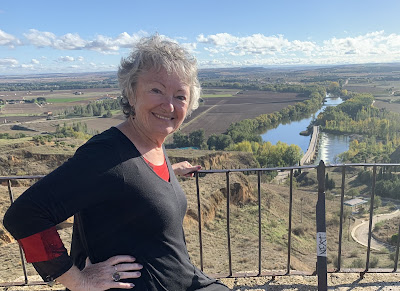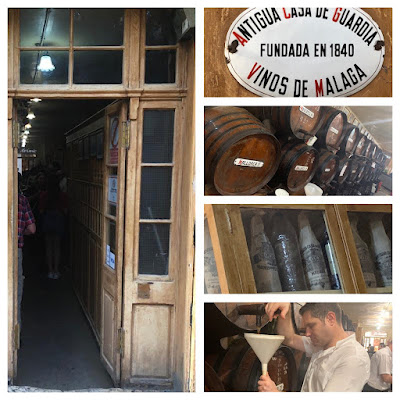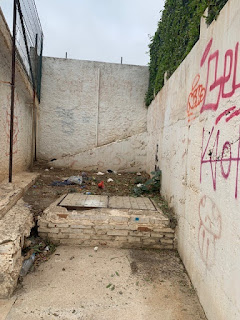MEDITERRÁNEA statue in Fuengirola has been my muse since 2017 and every time I visit Spain, she calls me back again. Yesterday was no different except this time her entire base (where I have stood for my photo shots) was filled with foreign salesmen; their blankets were spread out at her feet, filled with purses and shoes and watches, pretending to be the real articles. So, after only a moment of indecision, I grinned at my brother and started climbing up the back of the statue. This time, I got into the ship with her… It is different, but we were laughing and again, I walked away with a smile and another memory.

Steven and I walked the boardwalk and enjoyed the beautiful sea; fog lay thick over the water, so the view was limited, but not so bad that we missed the chiringuito restaurant on the sand. Hamacas littered the beach and at 72 degrees, we saw a few swimmers and dog walkers. For us, lunch was in order. I had a glass of vino tinto 🍷 and ordered gazpacho andaluz and Steven ordered boquerones fritas and a fish soup. When the waiter brought my gazpacho, my eyebrows shot up. In a glass? No vegetables swimming in its depths? Steven asked why it wasn’t in a bowl as it was an entre? The waiter looked confused. A bowl? This is the way it is served. We have a plate, like a bowl. Do you want one? I nodded no…the glass was fine. But, weird. I was glad Steven ordered the fried fish, and he was happy to share.
We peeked into little shops and meandered down the boardwalk. He bought his daughters gifts and I tried on flamenco shoes…polka dots! Then, he bought us each a chocolate covered ice cream bar and we enjoyed it all the way to the end of the street on our way to the car. We had a date with our friends, Lyn and Saidie, to go to a live music show in another town and we wanted to pretty ourselves up for it.
AND THEN THE CAR WAS NOT WHERE WE LEFT IT. It is easy to spot because there aren’t many yellow cars on the road. Steven knew where he’d parked it. I’d told him it was at the dead end of the boardwalk.
Steven: Are you sure this is the street?
Me: Absolutely. See the roundabout there? I pointed toward the end of the street.
Steven: Well, maybe it’s been towed? It costs 100 cash and another 200 euros to get it out. He had already gone through the experience earlier in his visit.
Me: Maybe it’s been stolen?
Steven looked glum, but we are both of the same disposition, so we talked about what we should do and thought of solutions. He made a phone call and we found that neither the police in Benalmádena nor the police in Mijas had the car. So, we presumed the car had, indeed, been stolen. We found a seat on a cement and tiled water fountain and discussed our options.
Steven: Well, the only thing I had in the car was my international driving license.
Me: Good. And then my heart sped up. My books are in the trunk! The Spanish translation of The Girl Immigrant books were in a box, waiting for the conference next week in Cáceres. I tried not to think about the books, since we were stranded in a coastal town about 15 miles from the condo. How will we get home? A taxi? A bus? What to do? Call police? Call rental car company? Call…? I took a deep breath and looked at my brother. He did not seem upset, maybe because he is a doctor in anger management or maybe because he is Steven, the boy who has always encouraged calmness.
Okay. The car was stolen and we needed to think. We walked up and down two other streets, although this was the one…that fed into the sea. Let’s sit down and a coffee to figure out what to do, I suggested. And that’s exactly what we did. The woman who took our order spoke a little English and she felt our pain. She showed me the taxi APP on her phone.
Me: I wonder if the car rental company has a GPS on the car? They could find it for us! I’d read so many books where that happened and thrashed around in my head for bits of random information.
Steven looked at his car rental contract on his email and called the place. His phone was nearly dead. Mine was close to 25%. This was the only day I had left my little jacket home along with the battery booster. The fog was now turning to a cool breeze. It would soon be dark. We drank our coffee and then Steven’s eyes lit up as he spoke to the rental company person on the other end of his dying phone.
Steven: YES, they have GPS on the car is parked close by! We high fives and he wrote down the street name and we finished our coffee. When he went inside to pay, he spied chocolate brownies oozing with frosting. He has trouble passing up anything chocolate, so he bought two of them. I wanted us to hurry so we could find the car before the thieves drove it away again. I was focused on our mission and my books. We followed the little blue dots on my GPS to Calle Héroes de Balen, almost at a trot.
Yes! When we saw that little yellow car, I wanted to kiss the hood as we walked quickly toward it. I glanced around for suspicious looking characters and then I saw the other roundabout. Two and a half hours of inner speculation and we were drinking coffee only a 5-minute walk away. My “absolutely this is the street” answer to his “are you sure this is the street” question now dissolved into relief. And my brother just grinned. He is the best travel companion! Although both emotionally drained, we decided riding inside that car felt wonderful. However by then we knew we would miss the music date, so we celebrated our car-finding-blessing with hot tea and the chocolate brownie when we walked in our door.
THAT ESCAPADE WAS YESTERDAY. Today, we relaxed because we have a birthday party to attend in Malaga at 10:30 tonight. The dinner and party hours here in Spain continue to amaze me. But before then, I’m off for a walk to meet Lyn and Saidie for lunch at the beach. The day is lovely, we have a car, I have my books and life is sweet.
 Paco does not know anything about his family on his abuela Clara Silván García side of the family tree. So, seeing the family immigration story listing Silván names took his breath away and brought tears to his eyes. He shared family names with us and pulled out a metal box filled with photos. He is a proud man, soft spoken and simpatico. His hug and cheek kisses were heart felt and he seemed to be filled with the family spirit like me, wanting to know about our families. I will post on the Silván Facebook sight for further information.
Paco does not know anything about his family on his abuela Clara Silván García side of the family tree. So, seeing the family immigration story listing Silván names took his breath away and brought tears to his eyes. He shared family names with us and pulled out a metal box filled with photos. He is a proud man, soft spoken and simpatico. His hug and cheek kisses were heart felt and he seemed to be filled with the family spirit like me, wanting to know about our families. I will post on the Silván Facebook sight for further information.














































